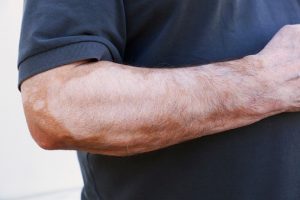
Study author Karin U. Schallreuter said, “To date, it is beyond any doubt that the sudden loss of the inherited skin and localized hair color can affect those individuals in many fundamental ways. The improvement of quality of life after total and even partial successful repigmentation has been documented.”
The researchers analyzed 2,411 patients with vitiligo where 57 had segmental vitiligo (SSV) and 76 had mixed vitiligo. Patients with SSV showed the same oxidative stress in their eyelashes and skin as seen in graying hair.
Gerald Weissmann, M.D., editor-in-chief of The FASEB Journal, added, “For generations, numerous remedies have been concocted to hide gray hair. But now, for the first time, an actual treatment that gets to the root of the problem has been developed. While this is exciting news, what’s even more exciting is that this also works for vitiligo. This condition, while technically cosmetic, can have serious socio-emotional effects of people. Developing an effective treatment for this condition has the potential to radically improve many people’s lives.”
Vitiligo skin disorder treatment may improve from modified protein
Researchers at Loyola University Chicago Stritch School of Medicine found that vitiligo skin disorder treatment may improve from a modified protein. Previous studies found that a protein called HSP70i plays a vital role in the autoimmune response that causes vitiligo. HSP70i consists of 641 amino acids and so the researchers modified the amino acids to create a mutant HSP70i.
The researchers gave the mutant HSP70i to mice that developed vitiligo and the mice fur turned back to black. The same effects on the mice were also seen in human skin specimens.
There are currently no long-term treatments for vitiligo, so a mutant HSP70i may offer new treatment options in the future.
Related Reading:
Vitiligo patients face dry eye syndrome, other eye health risks
Vitiligo patients face dry eye syndrome along with other eye health risks. Significant differences were seen in vitiligo patients who underwent the Schirmer test, which determines if the eye produces enough tears for proper moisture. Continue reading…
Vitiligo skin discoloration causes, symptoms, and unique treatment
Vitiligo is a skin condition that leads to light and dark patches of skin discoloration. Although vitiligo commonly affects the skin, it can affect any area that has pigment, for example, a person can develop patches of white hair. Continue reading…
Sources:
http://www.eurekalert.org/pub_releases/2013-05/foas-gha050313.php
http://www.fasebj.org/content/27/8/3113
https://www.sciencedaily.com/releases/2013/02/130227150908.htm